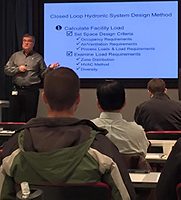On The Road: Bell & Gossett Little Red Schoolhouse

On March 14, I traveled “around the corner” to the Bell & Gossett, a Xylem brand, Little Red Schoolhouse located in Morton Grove, Illinois. I stopped in for day one of the three-day seminar focused on the design of large chilled water systems. Largely mechanical, consulting and specifying engineers made up the group of attendees, with the addition of one chiller manufacturer. This seminar, one of the schoolhouse’s more advanced offerings, features “deep dive” training, a plant tour and a product demonstration of offerings such as variable speed pumps.
The first presentation was led by instructor Stan Kutin, who has been working with the schoolhouse for more than 15 years. In his introduction, he explained that the key takeaways from the seminar would include pumping alternatives for secondary loops, pump operating costs, sensor location, hydronic balancing and economics of pumping methods.
Kutin kicked off the day with a look at designing old HVAC systems and hydronic systems. He discussed how in the 1970s, during the nation’s move toward efficiency, the industry came to realize that stand-alone chillers consumed a considerable amount of energy. As a result, equipment changes were made to fans, lower kilowatt-to-ton ratios, cooling towers and pumps. The result was modern chilled water systems (CHWs) that allowed for multi-building operation, single chiller plants and multiple parallel chillers.
Next, Kutin looked at designing hydronic systems that consist of source, load, air management/expansion and distribution systems. He shared the schoolhouse’s official methodology for this type of design, which includes the following steps:
- Calculate heat/loss gain
- Select major components like chiller, cooling tower, large pumps, etc.
- Layout the system piping
- Determine required water flow rate
- Size pipe
- Identify pump
- Air management and other hydronic specialties
A final design is the engineer’s choice, Kutin explained, a choice that takes into account design tool availability, compromise and overall consideration of the whole picture. It is the schoolhouse’s position that the most effective designs address install and operating costs, energy and maintenance, simplicity, flexibility and comfort.
The second presentation was led by Larry Konopacz, manager of Training and Education at Xylem. He started with a conversation on CHW and Direct Expansion (DX) loads. Konopacz pointed out that when working with these loads attention should be paid to refrigerant inventory, potential loss of refrigerant, environmental concerns, containment requirements and refrigerant costs. He listed ASHRAE’s Macro Design Criteria as a reliable guideline to reference when working on loads, specifically their Closed Loop Hydronic System Design Method.
Konopacz also covered part loads. He explained that in these situations lower supply air temperature is required, reheating is sometimes necessary to provide comfort, total heat transfer is reduced, and waterside flow rate is reduced with valves. Before the break for lunch, we also looked at suggestions for coils, and insulation and sizing for control valves and actuators. During this time, Konopacz showcased Bell & Gossett’s own design software. To have a look at their selection, sizing and CAD tools visit: http://bellgossett.com/selection-sizing-cad-tools.
After lunch, Kutin was back up to cover production loops. He explained that there are five chilled water sources: chillers, cooling towers, free-cooling, thermal storage and water source heat pumps. For chillers, Kutin noted, the most popular types that are used are rotary screw and centrifugal.
When it comes to cooling towers, there are some typical concerns. One concern is overhead piping. Common issues here include piping manifolds that result in low velocities, low velocity that allows air to be released, trapped air in piping that increases the head required, installation above purge level, and purged areas. Another concern is elevated suction piping. Common issues here include difficulty purging the condenser water pump, manual air venting, air accumulation, malfunction of automatic air venting, and cavitation. Kutin wrapped up the first part of the afternoon with discussions on compressor guidelines, tower characteristics, freeze protection, thermal storage and heat pump design.
After a short break, the second part of the afternoon started with a look at waterside economizers. Kutin also the led this session, opening with a broad look at economizer goals and definitions developed by ASHRAE. When considering economizer system designs, the main alternatives to note are cooling towers and heat exchangers, closed circuit cooling towers, refrigerant migration in chillers, and integrated and non-integrated economizers. Kutin also shared that alternative piping design considerations for economizers include multiple chiller or tower installations, single-plate and frame heat exchangers, and shared piping.
The day ended with discussions on cooling tower equipment operation and hydronic coil sizing. Surprising as it may seem, we only made it through about 25 percent of the binder attendees would be studying over the three days of training. I encourage all design, engineering and install professionals to check out the schoolhouse if you have not already. This well-known training institution has been educating our industry for more than 60 years. Learn how you can sign up today at www.bellgossett.com.




